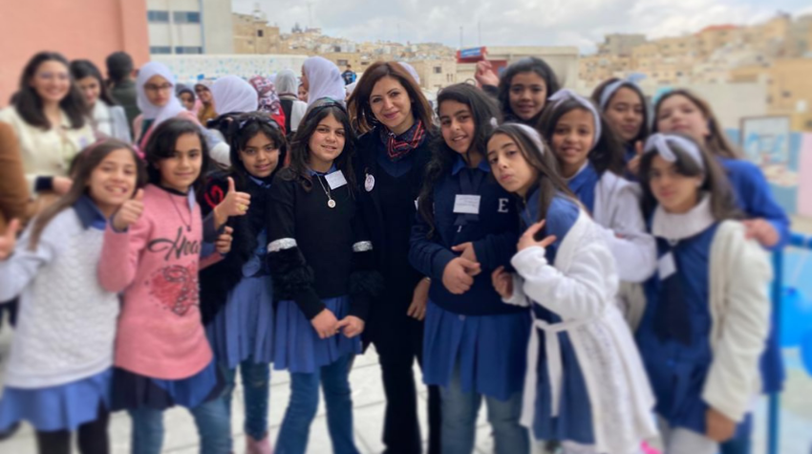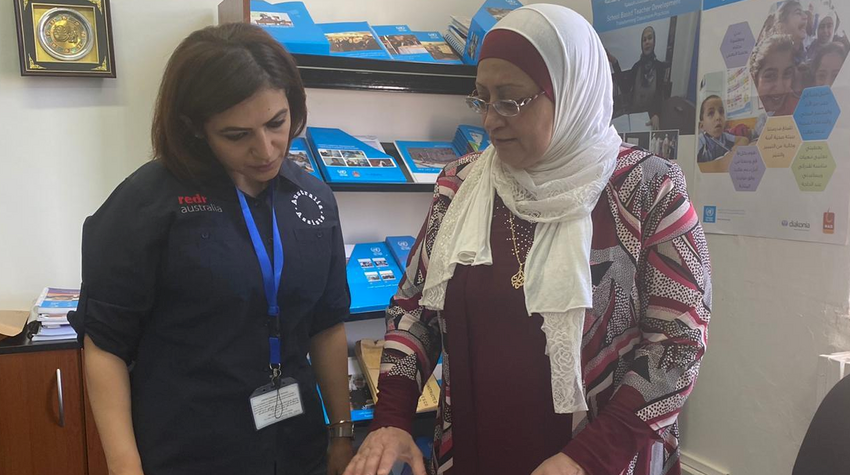While people with a disability are disproportionately affected by crisis and conflict, their needs and insights are often overlooked in humanitarian response efforts. RedR and CBM Australia are working with partners and deployees to make disability inclusion a priority.
In recent years, we have become all too aware of the language and logistics of emergencies and crises: watch and act, evacuate, lock down, follow public health orders, sanitise, get tested. We rely on and seek out this information. We trust emergency and crisis management plans and processes to keep us, our families and our communities safe.
But what if you’re one of the 1 in 7 people worldwide (as reported by the World Health Organisation) living with some form of disability? That’s 15 per cent of the global population, or more than 1 billion people, 80 per cent of whom live in developing countries where crisis and conflict are more common.
In crisis situations, such as natural hazards and conflict, people with a disability are disproportionately impacted. They face challenges fleeing danger and reaching safe areas, can become separated from family and friends who are key to their survival, and may lose vital equipment such as wheelchairs and prosthetics. They are also at greater risk of violence and discrimination, both during conflict and afterwards as displaced persons. At the same time, the number of people with a disability rises during crisis and conflict due to injuries and the breakdown of health systems.
Yet the needs and rights of those with a disability are often overlooked in the planning, response and recovery phases of humanitarian action.
“People with disability are too often forgotten or left behind in the humanitarian sector and in developing countries, especially when there’s an emergency, disaster or conflict,” said Jen Blyth, Inclusion Adviser with CBM Australia, an international development organisation dedicated to improving the lives of people with a disability.
All too often, people with disability are not consulted or involved in developing emergency or disaster processes and systems, said Jen. “This group of people must be able to speak for themselves and to access information before, during and after emergency events – just as everyone else does.”
For instance, people with disability should be consulted, along with the broader community, in developing a range of warning systems. Warnings such as sirens cannot be heard by deaf people, noted Jen, who is herself deaf.
“If there are differing warning sounds or patterns for different things, such as a cyclone or evacuation, people with a disability need to be able to hear these, know the differences and understand them,” she said.
Once disaster strikes, emergency shelters or places of last resort are often not accessible and, in an evacuation, people with a disability are frequently left behind due to inaccessible transport, a lack of help to move them or because they are just not seen as a priority.
In the aftermath of a disaster, it is also essential that accessibility and inclusion be integral to recovery plans. “New buildings must be accessible, and people with disabilities need equal access to support such as health care, food distribution and financial support,” said Jen.
Red R Strategy and Impact Manager Kylie Harrington said upholding and protecting the rights of people with a disability is everyone’s responsibility in a humanitarian response. “It’s not just up to specialists,” she said. “Whether you’re a staff member, deployee or training participant, we all need to look for those who aren’t being reached and work in a disability inclusive way.
“As humanitarians we should accept nothing less than a quality response – and a response isn’t quality unless it reaches everyone, especially those most at risk.”
To this end, RedR advocates to integrate disability inclusion objectives into deployment terms of reference with host organisations such as UN agencies and National Disaster Management offices, and engages Organisations of People with Disabilities (OPSs) such as the Pacific Disability Forum in Fiji to connect them with program partners. Through its partnership with CBM, RedR has also rolled out a range of other initiatives including online disability inclusion training for staff, associate trainers and roster members, developing and embedding new inclusive training guides, and preparing a disability inclusion tip sheet for deployees.
Australia Assists addressing inclusion in the disaster cycle
As implementing partner of the Australian Government’s Australia Assists civilian deployment program, RedR is responsible for progressing the program’s Disability Inclusion Strategy and Action Plan (DAP) which sets targets to ensure disability is effectively addressed across all stages of the disaster cycle, from preparation to response and recovery and stabilisation. As a party to the United Nations Convention on the Rights of Persons with Disabilities (CPRD), Australia has committed to supporting other countries to implement the CRPD, and ensuring our humanitarian efforts are inclusive and accessible to people with disability. The Development for All 2015-2021: Strategy for strengthening disability inclusive development in Australia’s aid program confirms this commitment and aims to promote improved quality of life of people with disability in developing countries.
Australia Assists not only deploys disability inclusion specialists to work with partners around the world, including the World Food Programme and United Nations Relief and Works Agency for Palestine Refugees in the Near East (UNRWA), it also builds the capacity of deployees with different skillsets and backgrounds to be disability champions. For instance, Australia Assists deployees, regardless of their specialisation, are briefed on disability inclusion in their pre-deployment briefings, and have access to one-on-one mentoring sessions with CBM specialists to discuss how to integrate disability inclusion into their roles. In the past year, 62 per cent of all Australia Assists deployees included disability inclusion outcomes in their reporting.
Inclusion in action
For Australia Assists deployee Mayada, disability inclusion is not a “nice to have”, but rather a fundamental right for people with disabilities to fully and effectively participate in, and be supported by, society.
“Disability is a cross-cutting issue,” said Mayada. “Inclusion specialists cannot work alone – there needs to be collaboration and integration with other programs, with open communication to share challenges and solutions.”
While the efforts of Mayada, the Australia Assists program and RedR are helping shift disability inclusion into the mainstream of humanitarian work, Jen said there is still a long way to go before inclusion becomes a priority across the sector.
“The biggest challenge remains ‘how’ to achieve disability inclusion,” she said. “There are many different layers to the barriers that must be overcome. People still need practical guidelines and advice on what it really looks like in practice.”
 Australia Assists deployee, Mayada is an Inclusive Education Officer with UNRWA in Jordan
Australia Assists deployee, Mayada is an Inclusive Education Officer with UNRWA in Jordan
Stronger together
To help address these needs, CBM has partnered with Australia Assists through RedR Australia, supporting efforts to integrate disability inclusion across all aspects of its operations – training, selecting and deploying professional humanitarians to work in communities impacted by crisis across the globe.
So what can humanitarian organisations do to put disability inclusion into action?
Jen has four key recommendations:
- Have a policy with a clear purpose and priorities that helps to foster a genuine appetite for and commitment to disability inclusion.
- Ensure the policy is led by both management and staff so it’s championed from the bottom up as well as the top down.
- Employ people with a disability. The need for inclusion gains more traction when there are people with a disability working around you.
- Engage with disabled people’s organisations in all aspects of your work to ensure appropriate, targeted disability inclusive actions.
Crucially, Jen said everyone in the sector needs to take responsibility for ensuring the needs and rights of people with disabilities are addressed “Disability inclusion is often considered to be someone else’s responsibility. But inclusion cannot be seen as ‘extra’ or an ‘add-on’; it must be thought of as a fundamental part of every element of the humanitarian program cycle.”


